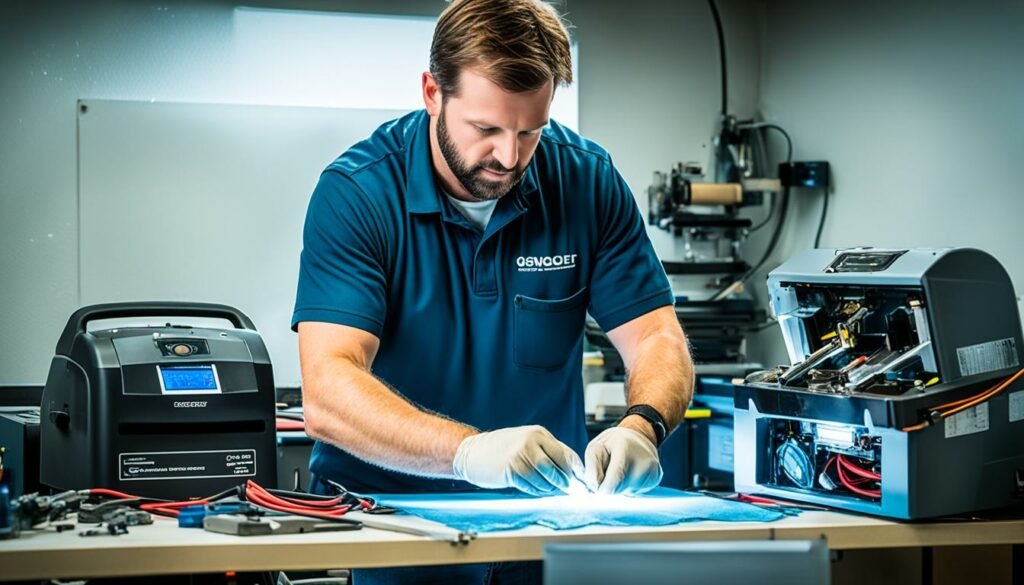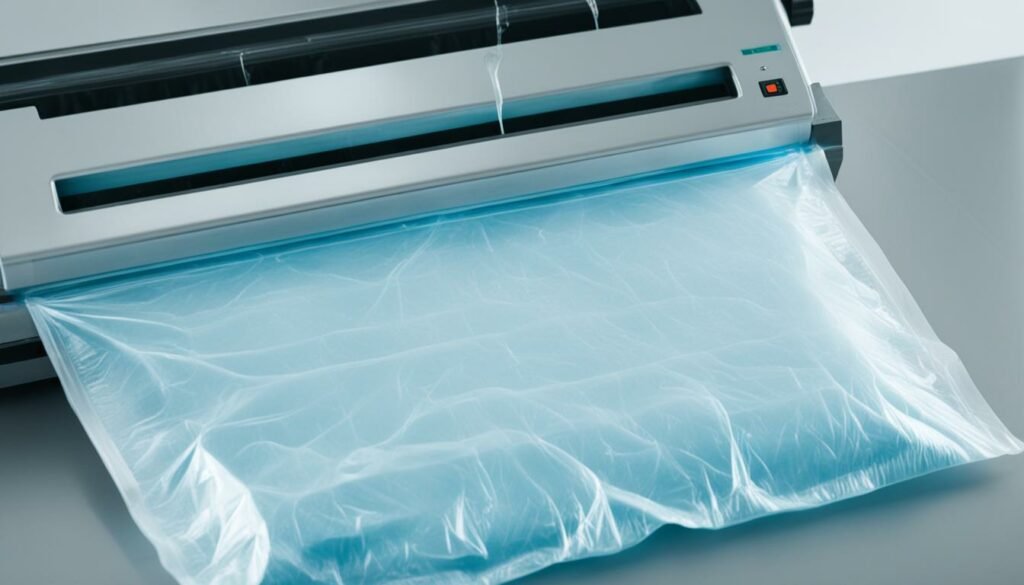Ever had your vacuum sealer suddenly stop working? This can leave your fresh food at risk of freezer burn. Vacuum sealing machines help keep food fresh. But, we often don’t notice them until they break.

Knowing why your sealer isn’t working is crucial. This guide covers everything you need to understand. From gaskets wearing out to issues with the vacuum pump, you’ll learn how to fix them. I’ll provide practical solutions to make your sealer work like new.
Let’s get into solving vacuum sealer issues so you can store food without worries. This could be due to how the bag is placed or power troubles. By the end of this guide, you’ll have the know-how to repair your vacuum sealer.
Understanding Common Sealing Problems in Vacuum Sealing Machines
Dealing with sealing problems in vacuum machines can seem tough at first. But, knowing the main causes makes fixing them easy. Recognizing these issues helps keep your vacuum sealer running smoothly.
Worn-out Sealing Gaskets
Sealing gaskets are key to making sure your food stays fresh. They wear out with time. If your sealer isn’t working well, check the gaskets. Keeping them in good condition stops problems before they start.
Improper Bag Placement
Putting bags in the machine the wrong way can cause sealing problems. Make sure your bag is smooth and properly placed to get a good seal. This is an important part of using a vacuum sealer correctly.
Moisture Issues
Moisture is bad news for your seal. Wet food or a damp seal can make sealing hard. Make sure the area is dry to avoid these problems.
Sealing Bar Problems
The sealing bar needs to be in top shape to create a good seal. If it doesn’t heat up right, your seals might be weak. Checking and fixing the bar is key to your sealer working well.
Vacuum Pump Malfunction
A vacuum pump that can’t remove air right messes up sealing. Things like clogs or a full drip tray can cause trouble. Keep your pump clean for it to work properly.
Electrical Power Issues
Electrical issues can also mess with your sealer. Check power cords to make sure everything’s in good shape. This simple step is vital for your sealer’s performance.
Troubleshooting Your Vacuum Sealer
Is your vacuum sealer acting up? It’s important to carefully check it out. We’ll show you how to fix common issues.
Inspecting the Sealing Gaskets
First, look at the sealing gaskets. They keep the seal tight. If they look worn, replace them. This often fixes sealing problems right away.
Verifying Bag Placement
Bad bag placement can cause seal issues. Make sure it’s flat and not too full. Folding the top part of the bag helps. Check out this vacuum sealer troubleshooting guide for more tips.
Checking the Sealing Bar
Make sure the sealing bar is clean. Even a little dust can mess up the seal. Clean and adjust it as needed.
For big leaks, you might need to set a longer seal time. This is common in vacuum chamber machines.
Removing Moisture
Moisture causes seal failures. Freeze food before sealing and dry the edges. Wipe away any wetness with a towel.
Assessing the Vacuum Pump
If it’s not sucking out air well, the pump might be blocked. If it looks foggy, the oil or filter might need a change. Adjusting the bolts can help too. A tripped breaker could mean a motor problem.
Looking into the pump is key for fixing your vacuum sealer.
Verifying Electrical Connections
Finally, check the wires and transformer. A dark panel or non-starting machine might need these fixed. See a vacuum sealer troubleshooting guide for help.
How to Solve Sealing Problems in Vacuum Sealing Machines
Solving problems in vacuum machines often starts with a few main steps. Many users notice a vacuum sealer seal strip replacement is needed over time. This happens because the seal strips wear out and stops sealing tightly. By changing them, your machine will work better. Also, not sealing the bags is a common issue. This shows the machine needs regular checking and fixing.
Adjusting the vacuum sealer seal time is also key. The right time to seal depends on what’s inside the bag and the material of the bag. Always check your vacuum sealer’s manual for how to adjust seal time. This part can be very different for each model.

Pay special attention to how you use your machine to tackle vacuum sealer seal issues. Putting too much in a bag often causes it not to seal well. So, make sure bags are not too full. Also, it’s important that the edges of the bag are clean and straight. Dirt or badly placed bags can stop the seal from being tight. Keep the machine’s sealing area clean and make sure the bags are properly positioned.
Checking and cleaning the sealing bar is another smart step. Dirt can build up and mess up the seal. Wiping down the sealing bar often prevents this problem. If it’s really dirty or worn out, you might need to change it. Many people have fixed seal issues just by cleaning the bar and the sealing surface regularly.
Sometimes, the machine has deeper issues like a broken vacuum sensor or pump. If the sensor shows there’s an issue, consider getting the machine checked by a professional. Finding the right replacement parts, like gaskets and sensors, can also be a problem. This highlights the need for better help from the makers of these machines.
By following these steps, many vacuum sealer seal issues can be fixed. This will make your machine last longer and work better.
Maintaining Your Vacuum Sealer for Optimal Performance
Keeping your vacuum sealer in great shape should be a top priority. To make sure it seals well and lasts long, clean it often, check it, store it right, use good-sealing bags, and don’t pack too much in.
Regular Cleaning
Keeping it clean is the first step. After each use, take time to wipe down the sealing bar and gaskets. This removes anything that might stop them from sealing properly. Clean parts mean a vacuum sealer that works well every time.
Regular Inspections
Checking your sealer regularly can prevent big issues. Early spotting of problems saves you from costly fixes and time without your sealer. This keeps your sealer working like new for years.
Properly Storing the Vacuum Sealer
Where you keep your sealer matters. It should be in a place that’s cool and dry, and away from the sun and dampness. This keeps it in good working condition for the future.
Using Compatible Sealer Bags
Choosing the right bags is very important. The bags you pick should fit your model well and be strong. This way, you won’t have issues sealing and your food won’t go to waste.
Avoiding Overfilled Bags
Don’t stuff the bags too full. Bags full to the brim can prevent a good seal. Leave some room at the top and your sealer will work better.
By looking after your vacuum sealer this way, it will work well every time. Not only that, but it’ll also help in saving food and last longer, giving you years of trusty service.
FAQ
How can I tell if my vacuum sealer has worn-out gaskets?
Look at the sealing gaskets for cracks, tears, or wear signs. If they are degraded, replace them. This keeps the seal tight.
What should I do if my vacuum sealer isn’t sealing properly due to bag placement?
Make sure the bag is flat and aligned well in the sealer. Avoid stuffing the bag too full and ensure there are no wrinkles.
How can moisture affect the sealing process in vacuum sealing machines?
Moisture can block the bag from sealing well. Always dry the sealing area before starting to seal.
What are common issues with the sealing bar in vacuum sealers?
The sealing bar can get dirty, hindering its work. Clean it often and look for damage to seal better.
How do I troubleshoot vacuum pump issues in my vacuum sealer?
Check the pump for blockages or faults. Make sure the drip tray is empty and the airways are open. If issues continue, it might need professional care.
What should I check if my vacuum sealer has electrical power issues?
First, check the power cord for damage and its connection. Make sure the outlet works. If it still doesn’t turn on, it might need professional help.
What steps should I take for regular vacuum sealer maintenance?
Clean the sealing bar and gaskets after every use. Check for wear regularly. Store it in a cool, dry place. Use the correct sealer bags and don’t overfill them.
How can I adjust the seal time on my vacuum sealer?
Follow the manufacturer’s steps to change the seal time. This might be needed for various bags or contents for the best seal.
What are the benefits of replacing the seal strip in a vacuum sealer?
By changing the seal strip, you improve the airtight seal. This means better food preservation and less leakage.
